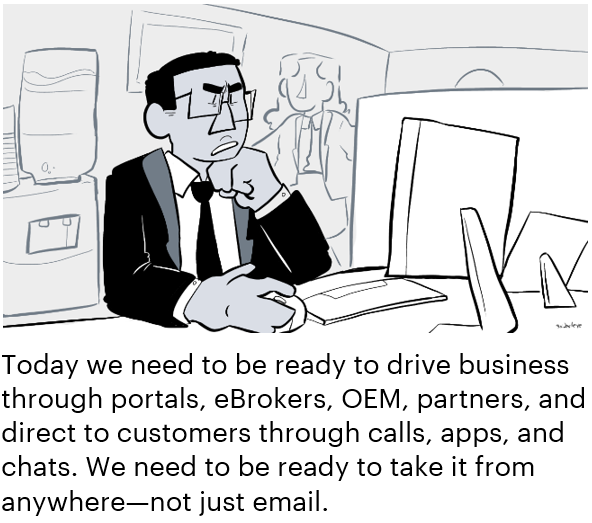Other parts of this series:
It has become an insurance tradition: every year, people declare that artificial intelligence (AI) and analytics will replace all underwriting in 10 years. Perhaps one day that will be true. But what is true today—and what will be true for some time to come—is that the best results for underwriting don’t come from replacing underwriters but from rethinking and retooling the connections between underwriters, data, and the rest of the organization.
In this series, we are going to look at the leading edge of underwriting today and discuss how proven technology solutions can transform the process to make it more efficient, more consistent, and more accurate in evaluating risk—not in 10 years but right now. You might be surprised at how a few modest changes can improve underwriting for everyone—from customers to distribution partners to underwriters themselves. Let’s explore five key parts along the underwriting journey and how data, design, and technology can build a brighter future for underwriting. Ultimately this can drive profitable growth and expense savings.
The five key parts are:
- Omnichannel Distribution: Creating a distribution network that finds the right customers and moves them to the right channel for you and for them.
- Intelligent Intake: Blending robotics, data, and redesign to transform how we take in and prepare submissions.
- Enabled Underwriting: Focuses on how the intersection of humans and machines can more intelligently and efficiently guide data-driven decisions.
- Collaborative Proposals: Seeks to move proposal delivery from disjointed emails to collaborative experiences of sharing, learning, and customizing winning solutions.
- Intuitive Onboarding: Leaving customers with a “wow” experience once the purchase to complete, rather than worry that they just made the wrong decision.
Part 1: Omnichannel Distribution
Today, we need to do business how our customers and partners want. For most business from our agents and brokers that will still be email; but email alone is not enough. We have to be ready to drive business through portals, eBrokers, OEM, partners, and direct to customers through calls, apps, and chats. And we need to be ready to take in new business from anywhere. In P&C commercial and group employee benefit insurance, we are seeing the ongoing consolidation of agent and broker channels. As these channels grow in power and influence, it puts carriers under pressure in terms of cost, price and access to new business. Ultimately, these forces are commoditizing insurance.

Carriers respond to commoditization
Carriers are pushing back against commoditization in two ways. First, some carriers are trying to distinguish themselves by being easier to work with for their distribution partners. This isn’t a new trend—carriers have used broker portals for years. But it is being pushed to new limits with direct connections to broker solutions through application programming interfaces (APIs), as well as the creation of apps, AI chat and other innovative models for certain service requests.
Other carriers are exploring alternative models for finding new customers beyond traditional agents and brokers:
- In small commercial, a number of different carriers such as Hartford and Chubb now have direct-to-consumer market plays that complement their agent models;
- Relationships with original service providers such as the hybrid insurance models being used with Lyft;
- Sales channels such as Mylo’s connection with LegalZoom.
What all this means is that the first step in transforming the underwriting experience is being open to better and new ways to connect with our distribution partners and customers. This isn’t just about new channels such as apps, chat, and portals. Real leaders here will think about the key needs of their partners and customers and then design selling experiences to meet their needs. It is time for underwriting to learn design.
To do this well, we recommend five key steps:
- Define your target customers (agents or the end customer) and do detailed research to understand their specific insurance, buying experience, and servicing needs.
- Define a clear approach for how customers are going to know about your offering and recent relevant changes you have made.
- Design and scope the experiences that will meet those needs, and ideally test the concepts and designs with a few customers.
- Design the technology, partners, and systems that can create your design. Build the budget and plan needed to implement it and determine target ROI.
- Develop and execute a pilot quickly, where you can learn and adjust your design before expanding it.
If you are interested in learning more about this process, I’d love to hear from you.










